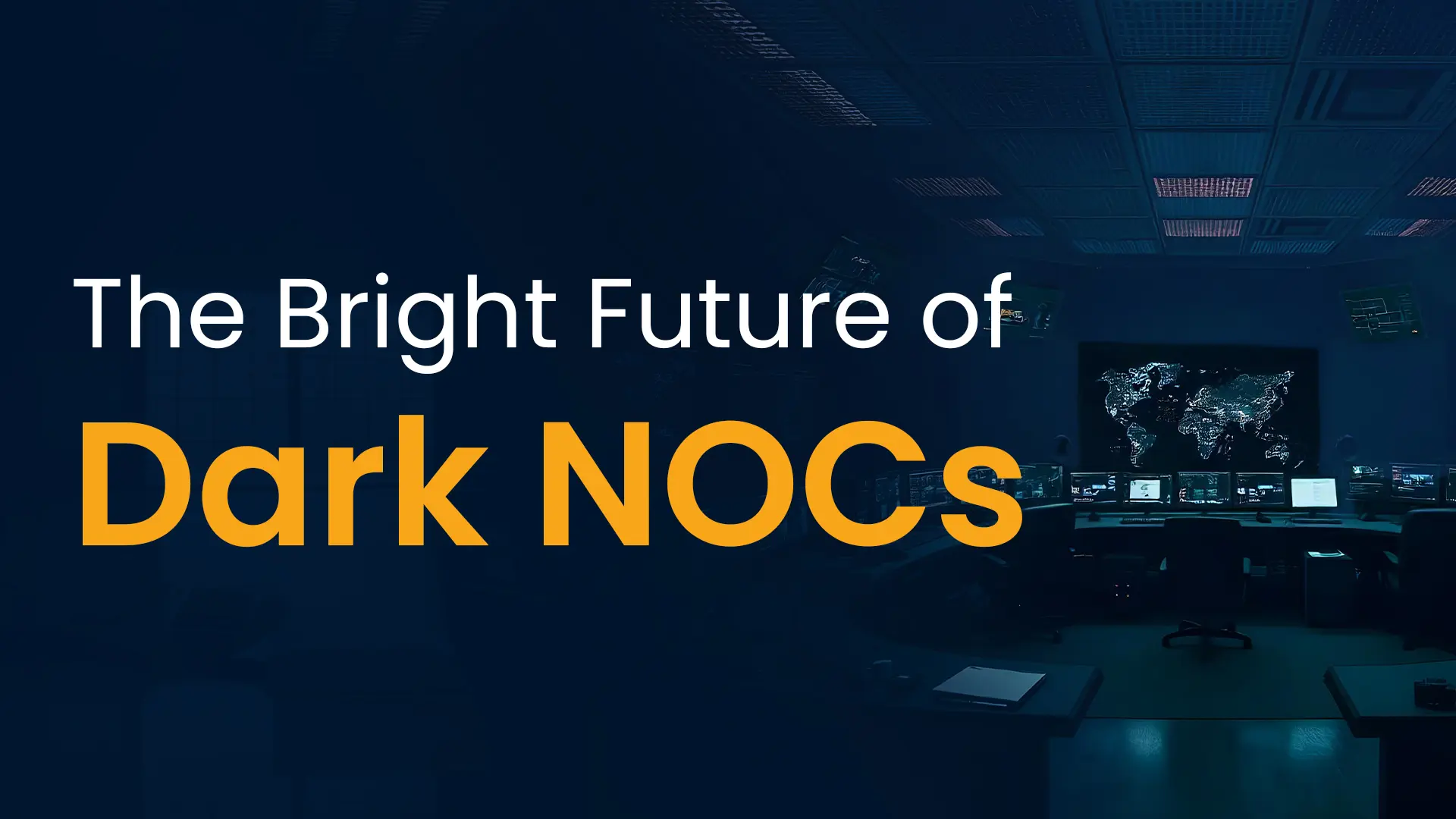Future State Target Operating Model for AI DC/Managed Private Cloud
Explore how autonomous NOCs powered by AI, ML, and automation will revolutionize network operations with unmatched intelligence, efficiency, and agility.
It’s the year 2035. In the dimly lit expanse of a swanky AI data center in downtown Dallas, the relentless whir of the server room fills the air, its rhythm occasionally punctuated by flashes of various alerts and alarms – predicting a hardware failure, an unexpected spike in network traffic, and a potential security breach. Having sensed these risks, the intelligent monitoring systems relay them in real-time to the Network Operations Center (NOC) in the bustling tech hub of Hyderabad – some 8900 miles away.
Upon receiving those signals, the NOC springs into action – first by confirming their validity through diagnostic tests and then by pinpointing the root cause of each issue through detailed log analysis. The severity and priority of each issue are determined. Servers at risk are identified, resources reallocated, workloads redistributed, and voila – in a matter of seconds, the load is balanced, performance bottlenecks are avoided, and potential threats are mitigated – even before they arise. Notably, this swift, silent, and sophisticated orchestration occurs without human intervention. Welcome to the NOC of the future.
The successor of today’s NOC will have enhanced analytical and predictive abilities and will be 100% autonomous – eliminating the need for eyes on the glass. Referred to as a ‘Dark NOC’ because of its ability to function flawlessly in the absence of light, this facility will be powered by AI and will be fully automated. It will operate with greater efficiency, agility, and reliability with the pulse of an intelligent, higher-order being straight out of science fiction – except this will be real. Issues, once managed by human hands, will fall under the vigilant gaze of a new breed of workforce – ‘digital employees’. Born of AI, ML, and automation, these intelligent systems will be designed to transform and support the workplaces of the future.
However, that’s not all. The NOC of the future will outperform the NOC of today in many more ways.
- Bot-driven Software The NOC of the future will automate routine network operations tasks such as incident detection, troubleshooting, and resolution management – using intelligent bots. These will leverage AI, ML, and automation to perform real-time analysis and decision-making, enabling faster and more accurate responses to network issues.
- 100% Automatic Monitoring Leveraging AI and ML, the NOC will continuously analyze network performance, detect anomalies, and predict potential failures – even before they materialize. This proactive approach will allow for real-time adjustments, ensuring optimal network health and service availability – without human intervention.
- Self-healing Capabilities AI-driven systems in the NOC will autonomously identify, diagnose, and resolve network issues. They will also automatically reallocate resources, apply patches, and adjust configurations while preventing potential disruptions, reducing downtime, and enhancing overall network reliability.
- Experience-focused Intelligent and intuitive systems in the NOC will focus on ensuring seamless and uninterrupted services through proactive network monitoring and management. These will utilize AI and ML to understand user behavior, predict their needs, and automatically optimize network settings to provide the best possible experience.
- Business Aligned Operations will be closely aligned with business goals and priorities. This alignment will ensure that the NOC prioritizes actions and resources based on the impact on business outcomes, including revenue generation, customer satisfaction, and operational efficiency. By closely integrating with business goals, the NOC will make more informed decisions, optimize network performance to support critical business functions, and contribute significantly to overall business success.
- Thresholds set up as per Business Criticality Thresholds will be set up per business criticality, allowing the system to triage alerts and prioritize responses based on the importance of different business functions. This will ensure that essential business operations and critical applications receive the highest level of attention and resources to maintain continuous performance, reliability, and availability.
Future Transformation of NOCs
Transitioning to the autonomous NOC of the future will also overcome current challenges, such as internal friction from excessive screens and siloed data, limited automation, and inefficient root cause analysis. It will address the increasing complexity brought by new technologies and multi-vendor environments. The shift will manage the rising data volume and alarm fatigue, ensuring critical alerts are not missed. The need for enhanced security, maintaining uptime, and adaptability will be met effectively. A unified tool landscape will replace fragmented systems, establishing a single source of truth and end-to-end orchestration.
The modernization will reduce the reliance on manual monitoring and address high turnover in support teams. It will streamline operations, enhance overall operational efficiency and security, and minimize downtime. Most significantly, it will address the growing complexity of network environments and the increasing volume of data and alerts straining current systems. Without this transformation, NOCs risk falling behind, losing relevance and competitiveness, and facing higher operational costs and reduced service reliability.
The global pace of this transformation is expected to be gradual, occurring over the next 10 years, but that clock has already begun. It will coincide perfectly with the massive hardware refresh data centers are undertaking over the next decade to support the explosive growth of AI and ML. They will expect their NOCs to align with new offerings of enhanced computing power, latency, and connectivity. Read our white paper, The Industry Blueprint for Capturing GenAI Value in 2025, to study this opportunity and stay ahead in your game.
Let’s address the million-dollar question: What are the prime considerations for minimizing disruption while ensuring a smooth transformation? Let’s look at them closely:
- Progress Incrementally Adopting a step-by-step approach is the key, as this will allow for thorough testing and integration. It’s important to remember that achieving 100% automation will take time and is not the prime objective initially.
- Shift to Cloud-Native Infrastructure Transitioning to cloud-native environments will enable scalable and flexible infrastructure and enhance agility, ensuring the NOC can efficiently handle dynamic network demands.
- Establish a Central Data Repository Developing a unified, vendor-agnostic, high-performance, and adaptable data repository will enhance visibility and decision-making across the network. Consolidating data from various sources into this single, unified platform will improve monitoring and management capabilities as it will provide a holistic view of the entire network.
- Automate Repetitive and Complex Tasks Utilizing AI, automation, and ML to handle repetitive and complex tasks will reduce manual workload and improve operational accuracy and speed. Automated detection of inventory changes, management of event storms and dips caused by singular root causes, and identification and escalation of abnormal behavior patterns will ensure consistent incident management. Additionally, continuous learning from event handling will further enhance the effectiveness of these processes.
- Focus on Actionable Insights Shifting to an ‘actionability mindset’ will drive effective automation and ensure that teams act on critical insights, streamlining operations and enhancing the impact of automation.
- Transition from Open to Closed Loops Moving towards closed-loop automation will ensure ongoing optimization and rapid response to network changes. This will be achieved by continuously using operational feedback to improve system performance.
- Implement Smart Ticketing and Data Mining Introducing intelligent ticketing systems and data mining practices will streamline issue resolution and provide deeper insights into network performance, further enhancing operational efficiency.
- Shift from Reactive to Proactive Management Developing processes that enable real-time issue identification and resolution, or even prevention, will reduce downtime and enhance the reliability of network services.
- Adopt Industry-Leading Root Cause Analysis Utilizing advanced tools to swiftly pinpoint, analyze, and resolve the root causes of service-impacting events will ensure prompt and accurate incident resolution.
- Leverage ML and Event Analytics Employing ML algorithms and event analytics to normalize data and detect patterns will enhance the predictive capabilities of the NOC, leading to better issue prevention and management.
- Detect Anomalies Using Data Streams Using data streams to identify anomalies such as temporal deviations, statistical rarities, and unusual behaviors will generate singular root causal events, filter out noise, and improve the accuracy and predictability of problem resolution.
- Implement Automated Full-Stack Observability Deploying tools that discover, map, and monitor all services and infrastructure components will provide comprehensive visibility. Real-time data analytics and AI-driven insights will proactively address incidents and improve overall network performance.
The Milestone Advantage
Milestone offers a comprehensive range of services to streamline data center and NOC operations. We successfully built a 24×7 NOC in Texas for a large e-commerce company, offsetting 60% of network-related notifications and allowing the client’s core network engineering team to focus on strategic efforts. Through proactive monitoring, management, and automation, we improved MTTR by 60% for an autonomous container terminal company and managed 9 million assets for a global tech giant’s data center.
With expertise in setting up autonomous NOCs and leveraging cloud, AI, and automation, Milestone enables businesses to boost productivity and performance while minimizing downtime and operational costs. Our AIOps-enabled monitoring and observability solutions enhance IT resiliency and application performance, providing businesses with deep insights, proactive visibility into their infrastructure and application environments, intelligence, and predictive capabilities.
Summing up
As data centers undergo a massive hardware refresh over the next decade – constituting the largest global capex cycle of the period, NOCs must become more intelligent and automated to ensure they remain relevant in the new ecosystem. Transitioning to a fully automated and autonomous NOC will be a gradual process best approached incrementally.
Businesses that start leveraging the cloud for scalability, establish a unified data repository for better visibility, and take the first step in automating repetitive tasks using AI and ML would be better positioned to advance to the next stage. For more actionable insights, read our white paper.




